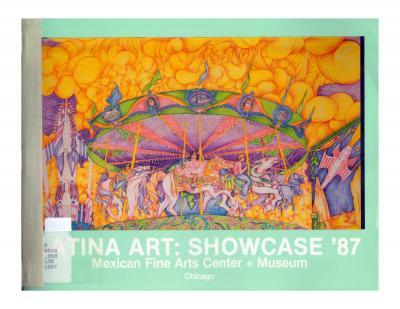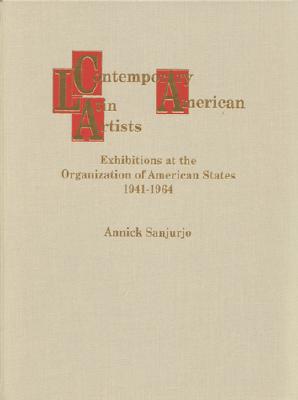Exhibition Catalogues

Frida Kahlo
In celebration of the one-hundredth anniversary of Kahlo's birth, this major new monograph is published on the occasion of the 2007-08 traveling exhibition. It features the artist's most renowned work--the hauntingly seductive and often brutal self-portraits--as well as a selection of key portraits and still lifes; more than 100 color plates, from Kahlo's earliest works, made in 1926, to her last, in 1954.

Latin American Paintings: From the collection of the Solomon R. Guggenheim Museum [Exhibition] July 2-September 14, 1969
The catalogue of paintings from the Latin American Collection of The Solomon R. Guggenheim Museum represents a selection of sixteen works from the twenty-six comprising the total collection. All works are reproduced in color or black and white, and are arranged, together with the catalogue information pertaining to each artist, in alphabetical sequence according to the artists' paternal surnames.

Latina Art: Showcase 1987
Latina artists have to face two major obstacles in having their artwork exhibited and appreciated: ethnocentrism and sexism. This 1987 show sought to acknowledge these obstacles and celebrate the artistic wonder, steadfast dedication, and determination that Latina artists must possess.

Memories of Underdevelopment: Art and the Decolonial Turn in Latin America, 1960-1985
Memories of Underdevelopment examines a major paradigm shift in culture and the visual arts, characterized by the articulation of a counter-narrative to the rhetoric of developmentalism that resulted in early instances of decolonial thought in the artistic practices produced in the region between the early 1960s and the mid-1980s.
Our America: the Latino Presence in American Art
Is Latino art an integral part of modern American art? Presenting over one hundred major artworks from the Smithsonian American Art Museum, Our America seeks to "recalibrate" enduring concepts about American national culture by exploring how one group of artists--those of Latin American descent and heritage--express their relationship to American art, history, and culture.

This Must Be the Place: Latin American Artists in New York, 1965–1975
"This Must Be the Place: Latin American Artists in New York, 1965-1975" is a two-part group exhibition exploring the work of a generation of migrants who created and exhibited in New York City between 1965 and 1975. Featuring installation, photography, video art, painting, and archival material, the exhibition brings together a generation that actively participated in experimental artistic movements while pushing forward their own visual languages and ideas, with works exploring topics of migration, identity, politics, exile, and nostalgia.
Monographs
Arte Latino
From portraits of family friends and famous individuals to the aesthetics of religious traditions from Puerto Rico to the American South-West, this guide celebrates Latin art, innovation, and tradition. It features art from the Smithsonian Museum.
/lc.jpg)
Artists from Latin American cultures: A Biographical Dictionary
This biographical dictionary profiles 75 artists from the United States and 13 nations of Central and South America and the Caribbean, including painters, sculptors, photographers, muralists, printmakers, installation artists, and performance artists. Some of their works recall pre-Columbian times; others confront the cultural imperialism of the U.S. over Latin America; and many explore how the dominant elements of culture can affect identities of class, gender, and sexuality.

Contemporary Latin American Artists: Exhibitions at the Organization of American States 1941-1964
This book contains information on internationally known artists who exhibited at the Museum of Modern Art of Latin America in the Organization of American States headquarters in Washington, D.C. from 1941-1964. The volume includes works exhibited and curricula vitae where available. A list of works exhibited has been added when it was missing from the original catalogue, and others have been corrected in accordance with the list used during the exhibition.

Latin American Women Artists of the United States
This work examines the art of 33 Latina-American artists and the manner in which these artists have merged Latino and North American cultures in their work. Juana Alicia, Leonora Arye, Santa Barraza, Pura Cruz, Linda Vallejo, Theresa Rosado, Joyce de Guatemala, and 26 other Latina-American artists are included.

New Art from Latin America: Expanding the Continent
Recent exhibitions and publications have attempted to describe the cultural production of Latin America as a definable entity, existing outside national or international contexts. This issue asks: what are the characteristics of "Latin Americanness" and how do the issues of identity and difference raised by such a categorization affect the work of artists practicing today? Contributions include essays on Alfredo Jaar, Eugenio Dittborn with Edward Lucie-Smith on Ricardo Cinalli, Chole Sayer on Mexican popular art, and David Elliot on young Argentinian artists.
/lc.jpg)
On art, artists, Latin America, and other utopias
In this book, Camnitzer reconstructs art history to include artists from the Latin American “periphery" through a series of essays that span forty years. His essays address several themes: the variations of simultaneous diasporas, artistic colonialism (historical, theoretical, and economic) in the context of the flawed mounting of art exhibits in the U.S.; the examination of Cuban biennials as an instance of the failure of Marxism to sustain utopian art; the role of Latin American artists in the construction of utopia; and the apathetic U.S. student activism of the late 1950s and 60s.

Readings in Latin American Modern Art
The book includes some fifty seminal essays and documents—including statements, interviews, and manifestoes by artists—that encompass the broad diversity of this emerging field. Many of these materials are difficult to access and some are translated here for the first time. Together the selections explore the breadth and depth of Latin American modern art as well as its distinctive evolution apart from American and European art history.
/lc.jpg)
The Americas Revealed: Collecting Colonial and Modern Latin American Art in the United States
The contributors to this volume trace the major milestones and emerging approaches to collecting and presenting Spanish Colonial and modern Latin American art by museums, galleries, private collections, and corporations from the late nineteenth to the twenty-first century.